Lung Cancer and Brain Tumours: A Complex Relationship


Intro
Lung cancer and brain tumours often intersect in ways that raise eyebrows within the medical community. Both can carry a heavy weight on patients and caregivers, complicating diagnosis and treatment options. Analyzing the connection between these two types of malignancies reveals a multifaceted relationship, where one may influence the other in notable ways. As we dig deeper into this subject, we will explore how these cancers interact, paving the way for a more informed understanding of their implications and treatments.
Background and Context
Overview of the Research Topic
The world of oncology is perpetually evolving, yet lung cancer and brain tumours pose significant hurdles that demand attention. Lung cancer remains a leading cause of cancer-related deaths globally, while brain tumours, although less common, bring unique challenges due to their location and effects on neurological function. The interplay between these two conditions emerges from the phenomenon of metastasis, where cancer cells from the lungs may travel to the brain, causing secondary brain tumours. This article aims to dissect this intricate relationship, shedding light on its clinical ramifications and the research efforts that seek to unravel its complexities.
Historical Significance
Historically, the understanding of cancer was often limited by the available technology and knowledge of the time. As treatments and research methods have developed, so too has the recognition of the interconnected nature of different cancer types.
- In the early 20th century, doctors began to comprehend that cancer does not simply live in isolation but can travel across the body, changing how they approached treatment.
- Studies dating back to the mid-20th century have revealed that lung cancer's propensity to spread to the brain is particularly pronounced, leading researchers to focus on creating therapeutic strategies that address this.
Understanding these historical milestones is crucial for anyone involved in oncology, as they highlight the ongoing quest for knowledge and better patient care.
Key Findings and Discussion
Major Results of the Study
Recent studies have revealed shocking correlations regarding the co-prevalence of lung cancer and brain tumours. Statistics indicate that roughly 40% of lung cancer patients may develop brain metastases at some point, suggesting a significant relationship worth exploring further. This underscores the necessity for vigilant monitoring and tailored treatment approaches for lung cancer patients.
Additionally, evidence shows that the specific type of lung cancer plays a crucial role in the likelihood of developing brain metastasis:
- Non-small cell lung cancer (NSCLC) is often linked with a higher incidence of brain metastases compared to small cell lung cancer (SCLC).
- Genetic markers and biomarkers of lung cancer have been identified that might predict the risk of brain involvement.
Detailed Analysis of Findings
The findings prompt a closer look at how treatment modalities can influence patient outcomes. Therapeutic strategies, such as targeted therapy and immunotherapy, have shown potential in curbing the disease's progression and managing brain metastases more effectively than traditional chemotherapy.
However, the dual diagnosis of lung cancer and brain tumours raises new questions about management:
- What role does early detection play in patient outcomes? An earlier diagnosis for lung cancer could potentially lead to a more proactive approach in monitoring for neurological symptoms.
- How can treatment options be tailored to minimize side effects? Striking the right balance between efficacy and quality of life becomes paramount when addressing such complex cases.
Epidemiology of Lung Cancer and Brain Tumours
Understanding the epidemiology of lung cancer and brain tumours provides critical insight into their interconnectedness, informing prevention, diagnosis, and treatment strategies. Each malignancy carries its own set of incidence rates and risk factors, and comprehending these can lead to better patient outcomes and targeted interventions. As the complexities of these diseases unfold, the examination of epidemiologic data offers a foundational context for prospective studies and clinical practices.
Incidence Rates and Demographics
Lung cancer maintains a notorious standing as one of the most prevalent cancers globally, often ranking as the leading cause of cancer-related mortality. Reportedly, the American Cancer Society notes that in the United States alone, about 238,000 new cases of lung cancer were anticipated in 2020. The demographic landscape reveals that certain cohorts exhibit significantly higher incidence rates.
- Age is a primary factor: Most cases are diagnosed in older adults, typically those aged 65 and older.
- Gender differences are also notable, historically more common in men, yet the gap is narrowing due to increasing smoking rates among women in certain regions.
- The socioeconomic status greatly affects these rates, as those in lower-income brackets often lack access to screening and healthcare resources.
These demographic patterns suggest that preventive measures must be tailored, factoring in age, gender, and socio-economic variables for effective outreach.
Risk Factors Associated with Each Cancer Type
The risk factors intertwining lung cancer and brain tumours share some commonality but also diverge significantly. For lung cancer, tobacco smoke is the most prominent risk factor, responsible for approximately 85% of cases. Other notable contributors include:
- Air pollution: Prolonged exposure to pollutants increases lung cancer risk.
- Occupational hazards, such as asbestos exposure and heavy metals.
On the flip side, the origin of brain tumours may stem from several sources:
- Genetic predisposition: Certain hereditary conditions like neurofibromatosis increase risk.
- Environmental exposure: Chemicals like vinyl chloride, or radiation exposure, are also implicated.
Understanding these factors not only emphasizes the need for targeted prevention campaigns but also essential screening practices within high-risk demographies.
Geographical Variations in Prevalence
Epidemiological studies reveal significant geographical variations in the prevalence of both lung cancer and brain tumours. For instance, lung cancer rates are markedly higher in industrialized regions due to elevated smoking rates and exposure to environmental toxins. Conversely, in some developing nations, there remains a stark absence of data, making it challenging to fully assess the situation.
- High prevalence areas include the Eastern European countries, strongly tied to tobacco use and air quality.
- In contrast, certain regions, particularly where tobacco usage is less prevalent and stringent air regulations exist, show significantly lower rates of lung cancer.
Brain tumours prefer a different backdrop, often displaying unpredictable patterns. For instance:
- Higher occurrences can be observed in urban areas, speculated to relate to varying environmental factors.
- Notably, certain regions exhibit clusters of specific tumour types — an area of ongoing investigation.
Biological Mechanisms of Lung Cancer Development
Understanding the biological mechanisms that contribute to lung cancer development is crucial for grasping the complexities of this disease, especially in relation to its impact on other malignancies, like brain tumours. Unraveling these mechanisms helps in identifying at-risk populations, enhancing preventive measures, and tailoring effective treatments. Lung cancer isn’t a one-size-fits-all scenario; it’s shaped by various genetic and environmental factors that communicate in sophisticated ways.
Genetic Mutations and Markers
Genetic mutations play a pivotal role in lung cancer. They can be viewed as the breadcrumbs that lead scientists and medical professionals through the labyrinth of the disease. Particular mutations in genes such as EGFR, ALK, and K-Ras have garnered significant attention for their association with distinct forms of lung cancer. These mutations can influence how aggressive a tumor may become and how it responds to treatment.
For instance, the presence of an EGFR mutation often prompts oncologists to prescribe targeted therapies, such as erlotinib and gefitinib, which can offer patients a fighting chance, particularly in non-small cell lung cancer. This specific approach to treatment showcases how genetic profiling of lung cancer can lead to more personalized care. Furthermore, identifying different biomarkers adds a layer of complexity, empowering practitioners with insight into cancer behavior and enabling risk stratification.
Adopting a proactive stance by identifying these markers early may help in creating more tailored screening programs, suited to demographic susceptibilities. Notably, the role of genetic testing will continue to evolve, providing vivid snapshots of a patient’s unique cancer profile.
Influence of Environmental Factors
When we consider lung cancer, we can’t overlook the environmental landscape that surrounds it. Various factors, ranging from pollution to occupational exposures, can precipitate the onset of this disease. Notably, exposure to tobacco smoke remains a leading cause of lung cancer, responsible for a staggering percentage of cases worldwide. Yet, it isn’t just smokers who are at risk; second-hand smoke poses significant hazards, particularly for vulnerable populations, including children and non-smoking adults.
Moreover, air pollution has emerged as a notable risk factor, correlating with higher incidence rates of lung cancer in urban areas. Conservatively, it has been suggested that even minor increases in exposure to fine particulate matter (PM2.5) can significantly elevate cancer risks over time, painting a rather grim picture for crowded metropolitan environments.
"The interaction between genetic predispositions and environmental influences forms a complex tapestry that underlines the interconnected nature of lung cancer development."
In addition to air quality, occupational hazards cannot be cast aside. Workers exposed to asbestos, radon, and certain industrial chemicals often find themselves grappling with a higher likelihood of developing lung cancer. Addressing these environmental exposures is paramount; awareness campaigns and stringent regulations could greatly mitigate risks.
The interplay between genetic mutations and environmental factors exemplifies the multifaceted nature of lung cancer. This understanding can lead to more comprehensive prevention strategies, thereby minimizing adverse health outcomes and improving population health management. In turn, greater insights into these biological mechanisms promise to pave the way for breakthroughs in treatments and prevention strategies, especially in contexts where lung cancer metastasizes to the brain.
Pathways of Brain Tumour Formation
Understanding the pathways that lead to brain tumour formation is crucial, particularly when considering its interplay with lung cancer. Brain tumours can emerge through various mechanisms, often influenced by genetic, environmental, and lifestyle factors. This topic encompasses a multitude of elements that highlight the complexity of oncological processes. By examining these pathways, we can better appreciate the intricacies of tumorigenesis, which aids in the identification of potential therapeutic targets and the development of more effective treatment strategies.
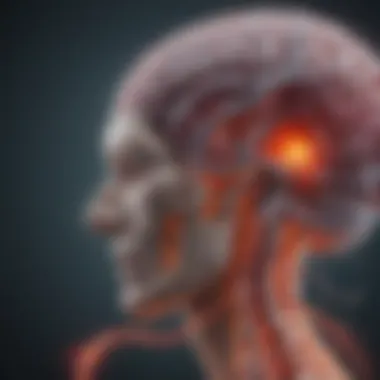
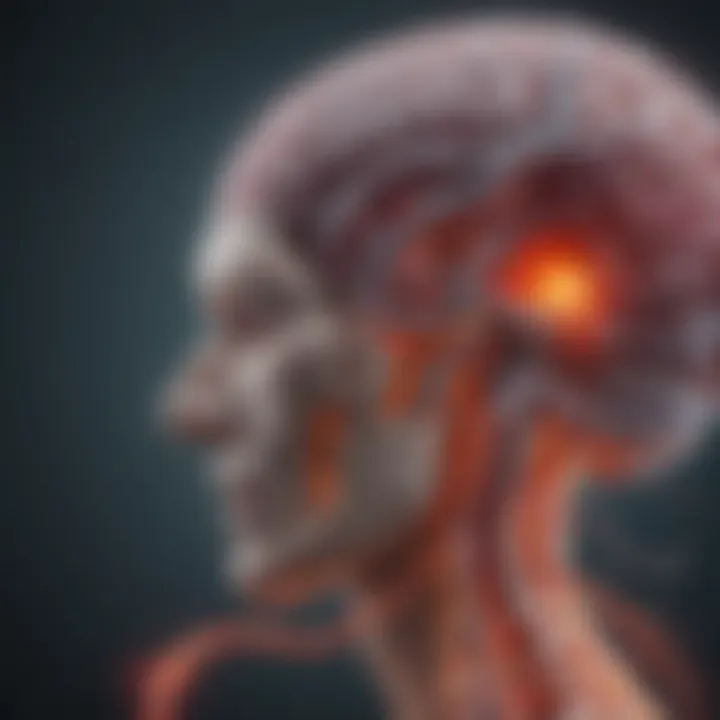
Types of Brain Tumours
Brain tumours are not a one-size-fits-all phenomenon; they can be classified into numerous types based on their cellular origin and location. Here’s a look at some prevalent types:
- Gliomas: These tumours arise from glial cells and account for a significant portion of all brain tumours. They can be further divided into subtypes such as astrocytomas, oligodendrogliomas, and ependymomas. Each subtype exhibits unique characteristics and behaviors.
- Meningiomas: These tumours develop from the meninges, the protective membranes covering the brain and spinal cord. Most meningiomas are benign, although some can be aggressive.
- Medulloblastomas: Typically found in children, these tumours originate in the cerebellum. They are known for their rapid growth and potential to spread to other parts of the central nervous system.
- Pituitary Tumours: These can be functional, producing hormones, or non-functional, not producing any hormones but leading to compression of nearby structures.
- Neurocytomas: A rarer type, these are generally low-grade tumours that can occur in the brain's ventricular system.
Identifying the type of brain tumour is fundamental for forming a precise diagnosis and tailoring the treatment plan accordingly. Each type presents its own challenges based on growth patterns and symptomatic presentations.
Role of Neuroinflammation
Neuroinflammation plays a pivotal role in brain tumour formation and progression. This inflammatory response occurs when activated immune cells target pathological stimuli, including injury or disease. Notably, recent research has underscored how sustained neuroinflammation can create a conducive environment for tumour cell growth.
- Immune Response: The immune system's initial response to potential threats can inadvertently promote tumour growth. Mediators of inflammation, such as cytokines and chemokines, can stimulate tumour cells while simultaneously dampening immune responses that would typically restrict their proliferation.
- Microenvironment: The inflammatory milieu surrounding brain tumours can facilitate their survival and growth. Tumour-associated microglia and astrocytes may support cancer cells by providing growth factors and promoting angiogenesis, the formation of new blood vessels that supply the tumour.
- Crosstalk with Lung Cancer: In cases where lung cancer metastasizes to the brain, neuroinflammation may serve as a bridge linking both malignancies. The inflammatory response could be a common pathway that affects patient outcomes and treatment responses in those with concurrent lung and brain cancers.
Understanding the role of neuroinflammation in brain tumour dynamics not only elucidates the biological underpinnings of tumour growth but also opens avenues for targeted therapeutic interventions.
Awareness of both the types of brain tumours and the implications of neuroinflammation directly informs clinical decision-making. It highlights the need for integrated treatment plans that address both the local brain environment and any systemic factors originating from lung cancer. This interplay fosters a more comprehensive approach to oncology, pushing research and treatment modalities into innovative territories.
Metastasis: Lung Cancer to Brain
Metastasis from lung cancer to the brain is a significant area of concern in oncology. This journey entails a series of highly complex biological processes that not only challenge traditional treatment approaches but also impose heavier burdens on patient management. Understanding these mechanisms gives us insights into prognosis, treatment options, and ultimately, the quality of life for patients affected by both conditions. The relevance cannot be overstated—brain metastases can severely affect patient outcomes and recovery trajectories.
Mechanisms of Cancer Spread
The pathways through which lung cancer cells reach the brain are intricate and multifaceted. There are several routes these malignant cells can take to migrate from the lungs to the cranial cavity:
- Lymphatic Spread: Channels of the lymphatic system can facilitate the transport of cancer cells. These cells travel through the lymph nodes, making their way up toward the brain.
- Hematogenous Spread: Most commonly, lung cancer cells can enter the bloodstream directly. Once these cells make it into the circulatory system, they can survive and proliferate in distant organs, including the brain.
- Parenchymal Displacement: This mechanism involves direct extension from lung lesions pushing through the tissues surrounding the lung, which can sometimes involve the mediastinum (area between the lungs) and affect nearby structures.
These mechanisms vary greatly with different cancer types and patient health dynamics, making targeted treatments even more complicated.
Clinical Implications of Metastasis
The clinical implications of lung cancer metastasizing to the brain are profound. Firstly, symptomatology is often exacerbated. Patients may experience an assortment of neurological symptoms which complicate the clinical picture. Common manifestations include:
- Headaches that are often more intense and frequent
- Seizures that can arise suddenly
- Cognitive changes, which can range from memory loss to difficulty concentrating
The presence of brain metastases typically leads to a need for a revised treatment plan. Options like radiation therapy or surgical intervention often become necessary to manage symptoms and control tumor growth in the brain. With this comes the critical aspect of multidisciplinary care, involving oncologists, neurosurgeons, and palliative care specialists working together to provide comprehensive management for the patient.
Moreover, the mental and emotional toll of brain metastases adds another layer to considerations of treatment. Patients and families may confront difficult decisions, balancing aggressiveness in treatment with the quality of life concerns. They may also require additional resources for emotional and psychological support.
"Addressing brain metastases is not just about managing cancer; it's about preserving dignity and well-being in the face of relentless challenges."
Understanding these implications fills in the gaps that statistics often overlook. By appreciating the full context, we can make informed decisions tailored to individual patient needs.
Symptoms and Clinical Presentations
Understanding the symptoms and clinical presentations of lung cancer and brain tumours is vital for early detection and effective management of these interconnected malignancies. The overlap in some symptoms between the two can complicate diagnosis, making awareness essential for patients and healthcare providers alike. Recognizing the distinct signs associated with each type of cancer allows for timely interventions and tailored treatment plans, ultimately improving patient outcomes.
Symptoms of Lung Cancer
Lung cancer often presents with a variety of symptoms that can be misleading at first glance. Initially, patients might experience symptoms commonly associated with respiratory illnesses. Some of the key symptoms include:
- Chronic Cough: A persistent cough that worsens over time can signal lung cancer. Unlike a typical cold, this cough is often dry and can produce blood in the later stages.
- Shortness of Breath: This sensation can range from mild to severe and is particularly alarming when it comes on suddenly during activities that previously did not cause any strain.
- Chest Pain: Discomfort or pain in the chest area can be related to the cancer itself or the pressure it applies to surrounding organs.
- Unintentional Weight Loss: Dramatic weight loss without dietary changes might indicate that the body is in distress due to cancer.
- Fatigue: A lack of energy that does not improve with rest may hint at an underlying serious condition.
These symptoms should not be taken lightly, especially in individuals who are at high risk, such as smokers or those with a family history of lung cancer. Early consultation with a healthcare provider is crucial.
Symptoms of Brain Tumour
Symptoms of brain tumours can vary greatly depending on the tumour's location, size, and growth rate. Some common indications may include:
- Headaches: Persistent headaches that are new or different from before can be a telltale sign. These headaches might intensify and often occur in the morning or wake the person from sleep.
- Seizures: New-onset seizures in an adult with no previous history can often indicate a brain tumour.
- Cognitive or Personality Changes: Patients may experience confusion, memory issues, or changes in behaviour, which are often subtle at first.
- Visual or Auditory Problems: Blurred vision, double vision, or hearing loss can point to pressure on the optic nerve or auditory pathways.
- Motor Impairments: Weakness in a limb or difficulty with coordination and balance can arise when specific areas of the brain are affected.
The symptoms associated with brain tumours can be easily mistaken for other disorders, emphasizing the need for thorough medical evaluation.
To summarize, recognizing the symptoms associated with lung cancer and brain tumours is essential for proper diagnosis and intervention. Both cancer types have overlapping symptoms that can complicate the clinical picture, thus increasing the urgency for collaborative efforts in diagnostics and treatment.
"Timely recognition of symptoms can be the difference between successful treatment and advanced disease stages."
Diagnostic Approaches for Lung Cancer and Brain Tumours
Diagnostic approaches represent the cornerstone of effective cancer management. Understanding how to accurately identify lung cancer and brain tumours is paramount not just for prompt intervention but also for tailoring treatment strategies to enhance patient outcomes. As these two malignancies often intersect, a robust diagnostic framework enables healthcare professionals to connect the dots between symptoms, imaging findings, and pathological results, ultimately guiding the patient down the right treatment path.
Timely and precise diagnosis can dramatically change the disease’s trajectory. This section delves into the specific elements that play a crucial role in the diagnosis of lung cancer and brain tumours, emphasizing the benefits of innovative technologies and the considerations that specialists should keep in mind.
Imaging Techniques and Their Role
Imaging plays a vital role in the diagnostic process. A variety of techniques allow clinicians to visualize the inside of the body, aiding in the identification and characterization of masses. When it comes to lung cancer, techniques such as chest X-rays and CT scans are typically the first line of assessment. These methods can reveal suspicious nodules or areas of consolidation that may require further investigation.
For brain tumours, MRI (Magnetic Resonance Imaging) is often the gold standard. It offers high-resolution images that can delineate tumor boundaries and differentiate between types of lesions. The choice of imaging technique often hinges on several factors, including the patient's overall health, the suspected malignancy, and local availability of technology.
"A picture is worth a thousand words" holds especially true in oncology, where imaging alone can unveil the hidden battles occurring within.
Some benefits of imaging techniques include:
- Early detection of abnormal growths.
- Monitoring tumor response to therapy.
- Assessing the feasibility of surgical options.
Despite their pivotal role, these techniques are not infallible. The limitations include:
- False positives and negatives can occur.
- Radiation exposure from certain techniques, like CT scans, raises procedural concerns, especially in younger patients.
In essence, imaging techniques substantially enhance diagnostic accuracy but should always be interpreted in conjunction with clinical findings and patient history.
Biopsy Procedures and Pathological Analysis
Once imaging suggests a suspicious mass, obtaining a biopsy is often the next step in establishing a definitive diagnosis. A biopsy involves extracting a sample of tissue from the tumor for pathological analysis. The type of biopsy performed can vary based on the tumor's location. For lung cancer, options may include bronchoscopy or a CT-guided needle biopsy. Each of these procedures has its own potential risks and benefits.
For brain tumours, the challenge lies in safely accessing the mass without exacerbating neurological deficits. Stereotactic biopsy techniques are commonly employed for their precision, allowing for targeted sampling while minimizing damage to surrounding healthy tissue.
Pathological analysis is invaluable in confirming the diagnosis and providing crucial information on the tumor type, grade, and potential molecular markers that may inform treatment choices. Key aspects include:
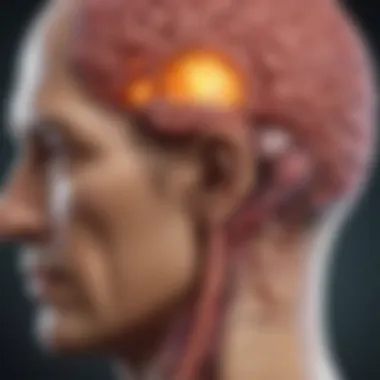
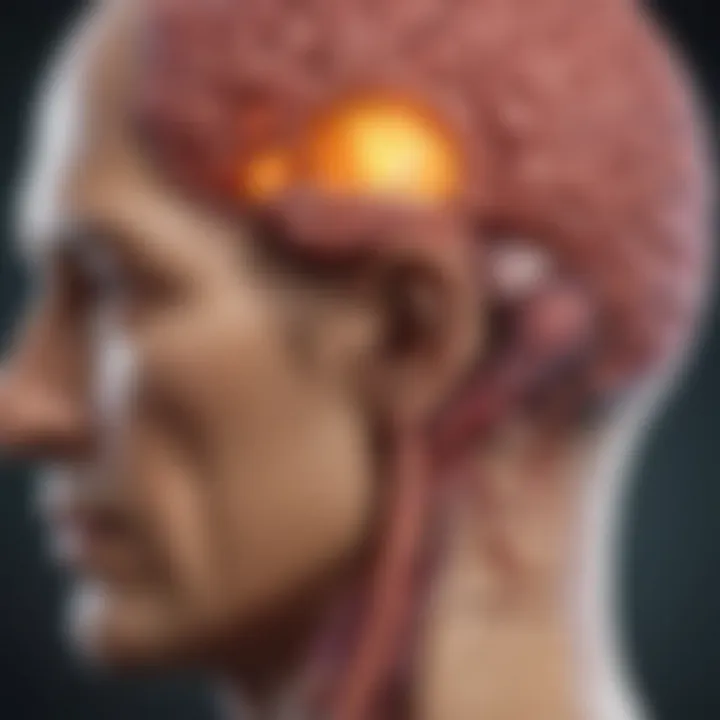
- Histological examination: Identifying the tumor type and its characteristics.
- Molecular analysis: Assessing specific mutations that could dictate targeted therapies.
In summary, both imaging and biopsy procedures contribute to the cornerstone of diagnosis in lung cancer and brain tumours. They set the stage for personalized treatment strategies and future prognostic evaluations. Engaging a multidisciplinary team ensures that each step, from imaging to pathological assessment, is aligned with best practices in patient care.
Therapeutic Modalities for Lung Cancer
Therapeutic modalities for lung cancer are critical as they create a multi-faceted approach to tackling one of the deadliest forms of cancer. Understanding these modalities varies widely, however, it's essential to emphasize that successful outcomes depend on early detection and proper management tailored to individual patient needs. With advancements in technology, these treatment strategies are becoming increasingly sophisticated, allowing for greater personalization in patient care.
Surgical Interventions
Surgical interventions play a pivotal role in the treatment of lung cancer, especially in early-stage cases where the malignancy is localized. There are generally three types of surgical procedures: lobectomy, pneumonectomy, and wedge resection. Each of these aims to remove the tumor along with a margin of healthy tissue to ensure that no cancerous cells remain.
- Lobectomy involves the removal of an entire lobe of the lung, which is often the preferred method when the tumor is confined.
- Pneumonectomy refers to the complete removal of one lung, reserved for larger or centrally located tumors.
- Wedge resection is the excision of a small section of lung tissue and can be applied in patients who may not tolerate more extensive surgeries.
The benefits of surgical interventions include improved survival rates, and for many patients, a chance to significantly alleviate symptoms associated with lung cancer.
However, several considerations need to be kept in mind. Not all patients are suitable candidates for surgery, especially those with comorbid conditions affecting lung function. Preoperative assessments are crucial, as they determine whether the benefits of surgery outweigh the risks.
Additionally, there’s the aspect of recovery. Patients may require pulmonary rehabilitation post-surgery to regain lung strength and function.
"Surgical interventions are the cornerstone in the treatment of operable lung cancer. Proper patient selection can lead to significant improvements in outcomes."
Chemotherapy and Targeted Therapies
Chemotherapy has long been a staple in the fight against lung cancer, often used as a neoadjuvant treatment to shrink tumors before surgery, or as an adjuvant treatment to eliminate remaining cancer cells post-surgery. Traditional chemotherapy can be quite aggressive, utilizing a cocktail of drugs that target rapidly dividing cells.
However, there's a growing focus on the use of targeted therapies. Unlike traditional chemotherapy, targeted therapies are designed to zero in on specific molecular targets associated with cancer. For instance, drugs like Erlotinib and Afatinib specifically target EGFR mutations commonly found in non-small cell lung cancer, improving treatment efficacy significantly.
The benefits of this approach are notable:
- Reduced side effects compared to conventional chemotherapy, as responses are more specific.
- Longer survival rates as they can slow the progression of the disease.
Nevertheless, the consideration of genetic testing becomes paramount to determine a patient's appropriateness for targeted therapies. Also, understanding the potential for resistance to these treatments is crucial, as tumours can evolve and become less responsive over time.
Treatment Options for Brain Tumours
The treatment options available for brain tumours are essential not only for patient prognosis but also for enhancing quality of life. Each patient's situation is unique, making it crucial to tailor therapies based on specific tumour types, locations, and individual health factors. By exploring the various therapeutic modalities, healthcare professionals can develop multi-faceted approaches to managing these complex conditions. Moreover, as research progresses, innovative treatment avenues show promise in delivering better outcomes for patients facing these health challenges.
Radiation Therapy and Its Applications
Radiation therapy remains a cornerstone in the management of brain tumours, often utilized both as a primary treatment and as an adjunct to surgery. This method employs high-energy particles or waves, such as X-rays or gamma rays, to destroy or damage cancerous cells. One of the remarkable features of radiation therapy is its ability to target precisely, leaving surrounding healthy brain tissue relatively unharmed.
There are various applications for radiation therapy:
- Stereotactic Radiosurgery (SRS): This non-invasive treatment delivers precisely targeted beams of radiation to tumour sites, making it useful for small tumours or those in difficult-to-reach locations.
- Fractionated Radiation Therapy: Typically involves multiple smaller doses over a period, allowing for the reduction of side effects while maintaining efficacy against the tumour.
- Whole-Brain Radiation Therapy (WBRT): This is often employed when there are multiple tumours or when metastasis is suspected, targeting the entire brain to minimize the risk of further tumour development.
Despite the benefits, it is vital to consider potential side effects of radiation therapy which can include fatigue, skin irritation, and changes in cognitive function. Patients should engage in discussions with their oncologist regarding the balance of potential benefits and risks.
Innovative Therapies in Clinical Trials
The landscape of brain tumour treatment is rapidly evolving, with innovative therapies emerging from clinical trials showing promising results. These experimental approaches aim not only to improve survival rates but also to refine the quality of life for those affected.
When we talk about innovative therapies, we can look at:
- Immunotherapy: This type activates the patient’s immune system to specifically attack cancer cells. Trials are underway studying immune checkpoint inhibitors, which can enhance the body’s ability to recognize and fight brain tumours.
- Targeted Therapy: These are designed to attack specific genetic mutations present in tumour cells. Drugs targeting BRAF or EGFR mutations are currently under examination, which may provide tailored treatment outcomes compared to conventional methods.
- Gene Therapy: Emerging research is exploring methods to insert genes into cancer cells to induce apoptosis or make them more susceptible to other treatments.
- Novel Drug Combinations: Some trials are testing synergistic approaches using established drugs alongside new agents to see if a combination can lead to better results than either treatment alone.
Staying updated with these clinical trials can offer hope to patients and families navigating the often-overwhelming journey of brain tumour treatment. Future breakthroughs could significantly shift the current paradigms of care, emphasizing the importance of ongoing research and educational initiatives in the field.
The Impact of Treatment on Quality of Life
The treatment of lung cancer and brain tumours can bring significant challenges that go far beyond the physical health of the patient. Understanding how therapies impact quality of life is crucial for anyone involved in oncological care. This understanding can guide discussions, shape treatment plans, and ultimately help improve outcomes for patients. The psychological and physical toll of these illnesses can drastically alter daily routines, health perceptions, and even relationships.
Physical well-being is often the focus when treating cancer. However, the importance of emotional and mental health cannot be overstated. A patient’s ability to cope with diagnosis and treatment may significantly influence their recovery and sense of hope. Therefore, assessing treatment's impact involves looking at both dimensions.
Assessing Patient Well-Being
Evaluating patient well-being can include various factors, such as pain management, emotional state, and social interactions. Simple yet effective approaches are often utilized:
- Surveys and Questionnaires: Tools like the Quality of Life Questionnaire can help gauge a patient’s emotional and physical well-being systematically.
- Regular Check-Ins: Scheduling frequent visits with healthcare providers can provide meaningful insights into how patients are feeling throughout their treatment journey.
- Supportive Networks: Encouraging patients to connect with support groups or psychological counseling can enhance their coping abilities as they deal with their battle against cancer.
These elements are fundamental. For instance, patients who report lower anxiety levels often have better treatment outcomes. It’s a two-way street; a supportive environment can lead to improved health status, which in turn can foster positivity.
Long-term Effects of Treatment
As treatments evolve, understanding their long-term effects on quality of life becomes essential. Survivors of lung cancer and brain tumours frequently encounter persistent challenges:
- Cognitive Changes: Treatments such as chemotherapy can lead to what some call "chemo brain", where patients experience memory lapses or difficulty focusing.
- Physical Limitations: Patients recovering from lung surgeries may struggle with breathing difficulties, while those who have undergone brain surgery might encounter coordination issues.
- Emotional Adjustments: Many survivors go through a rollercoaster of emotions as they adapt to life post-cancer treatment. This adjustment period can sometimes lead to depression or anxiety.
Adapting to these changes often takes a careful and compassionate approach. Key support systems within healthcare can make significant differences:
- Rehabilitation Services: Access to physical therapy can assist in regaining strength and mobility.
- Mental Health Resources: Engaging with a psychologist can help address emotional struggles arising from the cancer journey.
- Lifestyle Adjustments: Nutritionists or dietitians can provide personal dietary plans that enhance well-being and energy levels post-treatment.
"Cancer treatment is not just about survival; it’s about thriving and improving one's quality of life through the journey."
When considering treatment options, it is not only essential to weigh the benefits against potential side effects but also to understand how these decisions will impact the overall well-being of the patient. A comprehensive approach that integrates physical, emotional, and social dimensions will ultimately enhance the quality of life for those navigating the treacherous waters of lung cancer and brain tumours.
Research Advances in Oncology
Research advances in oncology have been a cornerstone in understanding and combating cancer, specifically in regard to the interconnected challenges posed by lung cancer and brain tumours. These advancements are significant for multiple reasons: they enhance our understanding of cancer biology, improve diagnostic techniques, and develop novel therapeutic options, all of which impact patient care. Staying abreast of the latest research can illuminate pathways that might not only treat the current patient populations but also prevent future occurrences. By examining research, we unravel key insights that can shift current paradigms in treatment.
Current Studies on Lung Cancer
Current studies on lung cancer are expansive, touching on various aspects from molecular pathology to treatment responses. One prominent area of investigation is the role of genetic mutations in non-small cell lung cancer (NSCLC). Research efforts have been directed towards identifying specific mutations, such as those in the EGFR (Epidermal Growth Factor Receptor) gene. Targeted therapies aimed at these mutations have shown promise in improving patient outcomes. For instance, osimertinib has become a key agent in treating mutations associated with lung cancer, yielding significant improvements in survival rates.
Other studies are delving into the impact of immunotherapy in lung cancer treatment. The use of PD-1 (Programmed Death-1) inhibitors has opened up new avenues, as they help the immune system recognize and combat cancer cells more effectively. Research shows that combining these agents with traditional treatments could yield better results, increasing response rates in advanced stages of the disease.
Furthermore, researchers are scrutinizing socioeconomic factors and their influence on treatment access and effectiveness. Understanding how these factors interweave with healthcare delivery may lead to more equitable approaches in oncology.
Ongoing Research in Brain Tumour Pathogenesis
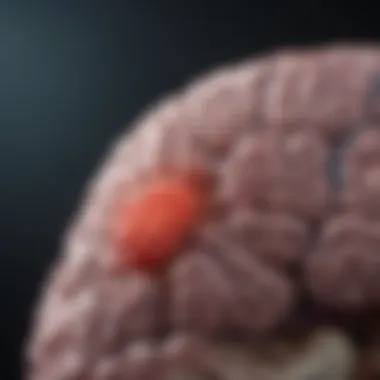
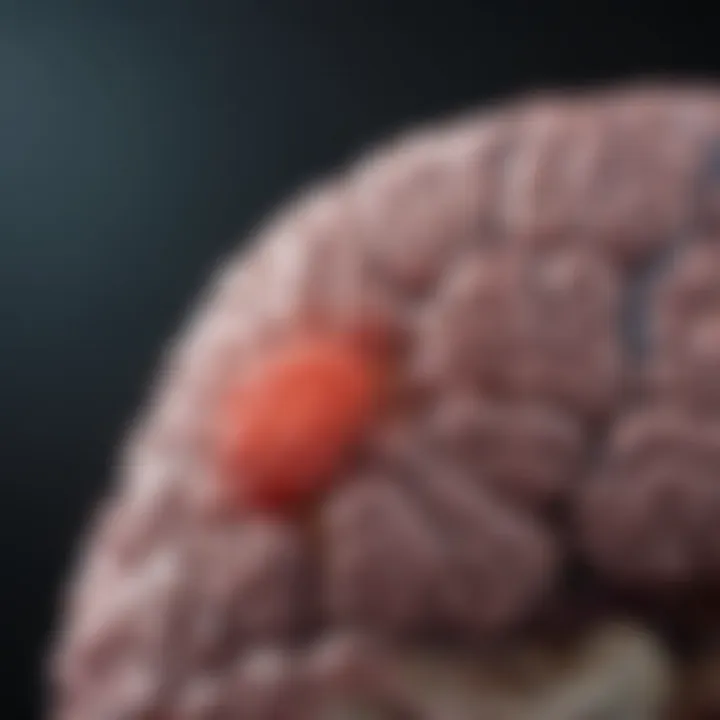
Ongoing research in brain tumour pathogenesis is equally crucial. Scientists are investigating the molecular signatures that define various types of brain tumours, such as glioblastomas. For example, understanding the aberrant signaling pathways involved in these tumours can help in the creation of targeted therapies aimed at specific cellular alterations.
Additionally, researchers are focused on the role of the tumour microenvironment and how it supports brain tumour growth. The interaction between cancer cells and the surrounding non-cancerous cells can significantly influence the progression of the disease. Innovative techniques like single-cell RNA sequencing are providing insights into these interactions, revealing previously hidden complexities that could be targeted therapeutically.
The implications of this research reach far beyond treatment. Studies also explore how external factors, such as radiation exposure and genetic predispositions, contribute to the development of brain tumours. This knowledge can inform community health initiatives and lead to preventive strategies aimed at reducing risk.
"Understanding the intricate connections between lung cancer and brain tumours is crucial not just for treatment but also for advancing preventive measures at a public health level."
Psychosocial Considerations for Patients and Families
Cancer diagnoses have a ripple effect that touches not just the patients but their families and communities. The intertwined challenges of lung cancer and brain tumours present profound psychosocial concerns. Understanding these aspects is crucial, as they help to shape not only the treatment journey but also the quality of life for everyone involved.
When individuals face a cancer diagnosis, the immediate emotional response can be overwhelming. Fear, uncertainty, and feelings of isolation often dominate their thoughts. For families, these emotional battles are compounded by the need to support their loved ones while grappling with their own fears and concerns. This section explores how emotional support and coping mechanisms play a vital role in navigating this difficult terrain.
Emotional Support Resources
Various resources can provide critical emotional support to patients and their families. Among the most impactful are:
- Support Groups: Both lung cancer and brain tumour support groups create a sense of community. They provide a platform for sharing experiences, which can alleviate feelings of isolation. Patients often find comfort in hearing others' journeys.
- Counselling Services: Professional counsel offers patients and families an outlet to express their fears and emotions. Trained therapists can help individuals process their feelings and provide coping strategies tailored to their unique situations.
- Online Platforms: The digital age has brought about numerous online support resources. Websites like reddit.com host communities focused on specific cancers, offering anonymity alongside shared experiences and advice.
- Hospital-Based Programs: Many hospitals now include psychological support as part of their cancer care. This multidisciplinary approach ensures emotional wellness is prioritized alongside physical treatment.
Providing immediate access to these resources can lead to significant improvements in emotional wellbeing. Patients often feel more empowered when they know they’re not alone in their journey.
Coping Mechanisms for Families
When a loved one battles cancer, families face their own set of challenges. They bear the burden of emotional turmoil while providing necessary support. Here are some effective coping mechanisms families can adopt:
- Open Communication: Families should encourage honest discussions about feelings and fears. Sharing thoughts fosters a strong emotional connection that enables everyone involved to feel heard and understood.
- Establishing Routines: Normalcy can be incredibly comforting. Families might find it helpful to maintain routines, such as family meals or game nights. These moments provide a sense of stability amid chaos.
- Shared Activities: Engaging in joint activities, whether it be watching movies or going on walks, allows both patients and families to bond over shared experiences. These can be invaluable in reinforcing relationships.
- Education about the Illness: Learning about lung cancer and brain tumours helps families understand what their loved one is experiencing. Knowledge can dispel fears and create a supportive environment.
- Mindfulness and Relaxation Techniques: Incorporating practices such as meditation or yoga can help alleviate stress. These techniques assist in fostering a sense of calm within a challenging environment.
"The journey through cancer is challenging for patients and families alike; understanding emotional needs and coping strategies can greatly enhance the quality of life during this trying time."
Incorporating these psychosocial considerations not only helps patients feel cared for but also ensures that family members' needs are recognized. Fostering strong support structures can enhance the overall journey through treatment while acknowledging the emotional landscape that accompanies such diagnoses.
Implications for Public Health Policy
The intertwining crises of lung cancer and brain tumours present a significant challenge to public health policymakers. Addressing these conditions requires a multifaceted approach that encompasses prevention, education, and advocacy to better serve communities and individuals affected by these diseases.
Preventative Measures and Education
Effective prevention and education strategies are the cornerstones for tackling the rising incidence of lung cancer and brain tumours. Educating the public about the risk factors associated with these cancers is critical. For lung cancer, the major cause lies in smoking, a preventable behavior. Public health initiatives must aggressively target smoking cessation programs, encouraging individuals to quit through counseling, support groups, and legislative measures such as higher tobacco taxes and smoking bans in public areas.
Living a healthier lifestyle can mitigate some risks. Awareness campaigns can promote:
- Avoidance of secondhand smoke: It’s essential for non-smokers to understand the dangers posed by exposure to smoke.
- Healthy air quality: Educating individuals about environmental issues such as air pollution can guide them in making conscious choices about where to live and how to minimize exposure to harmful emissions.
- Regular screenings: For those at high risk, especially smokers or individuals with a family history of lung cancer, breathing easier through periodic check-ups can lead to earlier diagnosis and improved outcomes.
Regarding brain tumours, information dissemination about possible signs and symptoms is equally imperative. Encouraging medical consultations for headache patterns, memory issues, or coordination problems might facilitate quicker diagnoses, ultimately enhancing survival rates. Utilizing social media, community workshops, and school programs can spread knowledge effectively to diverse populations.
Advocacy for Research Funding
Advocacy for increased research funding is vital for ongoing advancements in understanding and treating lung cancer and brain tumours. Policymakers must recognize that investing in research yields substantial returns—from not only improving treatment options but also enhancing the quality of life for patients. Engaging legislators in discussions about the economic burden of these diseases can emphasize the need for support in research initiatives.
Funding can be directed toward:
- Innovative clinical trials: Finding new ways to understand tumor biology might lead to game-changing treatments.
- Collaborative research efforts: Public-private partnerships can share resources and knowledge across institutions to accelerate scientific discoveries.
- Education of researchers: Supporting training programs ensures that the next generation of scientists is well-prepared to tackle these complex problems.
"Investing in research is like paving the road to future discoveries, making journeys shorter for patients who face daunting hurdles today."
By embedding these strategies within public health policies, we can create a robust framework that addresses the intertwined challenges of lung cancer and brain tumours. Ultimately, the drive towards education, prevention, and research funding stands to empower individual patients and enhance community health.
Ethical Considerations in Cancer Treatment
The realm of cancer treatment is fraught with ethical considerations that are vital, not just for practitioners and researchers, but also for patients and their families. In the context of lung cancer and brain tumours, understanding these ethical dimensions allows us to engage more thoughtfully with the challenges surrounding diagnosis, treatment options, and implications for patients’ lives. This article unpacks several essential facets of these considerations as they intersect with the field of oncology.
Informed Consent and Patient Autonomy
Informed consent stands as a fundamental principle in medical ethics. It embodies the right of patients to receive comprehensive information about their diagnosis and treatment options, thereby empowering them to make choices about their healthcare. For individuals facing lung cancer or brain tumours, the stakes can be incredibly high.
- The need for transparency in communicating risks and benefits of treatments is paramount. Patients must understand not only what a particular therapy entails but also its potential side effects. For instance, when patients are presented with chemotherapy plans, clarity around possible hair loss, fatigue, or nausea can guide them in making more informed choices.
- Autonomy in decision-making is crucial. Respecting a patient’s wishes, even if they choose not to pursue certain treatments, reinforces their agency in the healthcare process. This underscores a patient-centric approach, rather than a directive one, allowing individuals to have a say in their own health trajectories.
By prioritizing informed consent, healthcare providers can build trust and rapport with their patients. Open dialogue fosters a collaborative atmosphere, where patients feel supported in exploring all areas of their treatment options.
Ethical Dilemmas in Clinical Trials
Participation in clinical trials can offer patients new hope but also raises complex ethical dilemmas. When it comes to lung cancer and brain tumours, the urgent need for innovative treatments clashes with the necessity of ensuring that patients are not only participants but also protectees in the process.
Key considerations include:
- Equitable Access: Not all patients have the same access to clinical trials, which can lead to disparities in treatment outcomes. This raises questions about fairness in offering life-saving therapies that should ideally be available to all individuals, regardless of socioeconomic status.
- Informed Participation: As mentioned earlier, informed consent is crucial, yet many patients may feel coerced into joining trials out of desperation for successful treatment. It’s essential that they understand both the potential benefits and the uncertainties involved.
- Placebo Controls: Ethical concerns also arise when trials involve placebo groups—especially when an effective existing treatment is available. Patients with advanced lung cancer or aggressive brain tumours may question the moral implications of receiving a placebo instead of treatment that could potentially prolong their lives.
Navigating the ethical waters of clinical trials necessitates a balance between innovation and the inherent rights of patients.
In closing, addressing ethical considerations in cancer treatment—specifically around informed consent and the complexities of clinical trials—provides a clearer view of the patient experience. As researchers and clinicians continue to advance in treatment methodologies for lung cancer and brain tumours, it is more imperative than ever to uphold ethical standards that prioritize patient welfare. By intertwining clinical insight with ethical diligence, a more equitable healthcare landscape can emerge.
Ending: Connecting Lung Cancer and Brain Tumours
Understanding the intricate interplay between lung cancer and brain tumours is crucial in the realm of oncology. This connection not only sheds light on the biological mechanisms behind metastasis but also amplifies the importance of a holistic approach to patient care. As we have explored throughout this article, these two malignancies share risk factors and impact each other’s progression and treatment.
Addressing lung cancer can inadvertently influence brain tumour outcomes, making early detection and integrated treatment strategies essential. Such considerations are pivotal in improving patients’ quality of life, addressing not just the physical symptoms but also the emotional and psychological toll of dual diagnoses.
"The whole is greater than the sum of its parts." - This concept rings particularly true when examining the bond between lung cancer and brain tumours. Incorporating research and clinical data from both cancers allows for a more comprehensive understanding of patient management.
As we move forward, this interconnectedness should inform future research directions and clinical practices alike, focusing on developing more effective treatments and therapeutic modalities that consider both conditions together.
Future Directions in Research
The exploration of lung cancer and brain tumours opens new avenues for research.
- Mechanisms of Metastasis: Investigating how lung cancer cells migrate to the brain can reveal crucial targets for intervention.
- Genetic Studies: Understanding the genetic predispositions that link both cancer types might pave the way for personalized treatment options.
- Immunotherapy: As this field evolves, studies should assess the effectiveness of immunotherapeutic strategies in lung cancer patients at risk of developing brain tumours.
Furthermore, collaborative studies involving multidisciplinary teams can help capture a fuller picture of the challenges faced by patients affected by both malignancies.
Summarizing Clinical Insights
The synthesis of clinical insights gathered through this examination shows the need for enhanced patient management strategies that encompass both lung cancer and brain tumours. Key takeaways include:
- Early Detection: Reinforcing the importance of screening for brain metastasis in lung cancer patients to allow timely intervention.
- Comprehensive Care: Fostering a treatment approach that considers both the physical and emotional aspects of care, as patients deal with the stressors of multiple diagnoses.
- Patient Education: Empowering patients with knowledge about potential risks and symptoms can enable them to advocate more effectively for their health.







